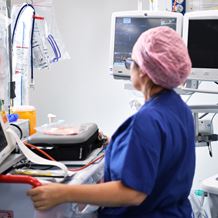
- Home
- Services
- Cardiac Services
- Procedures and Treatments
- Coronary Angioplasty and Stents
What is coronary angioplasty and stenting?
Coronary angioplasty and stenting, sometimes referred to as percutaneous coronary intervention (PCI), is a procedure used to treat coronary artery disease where the arteries have become narrowed or blocked. These arteries play an important role in keeping you healthy. In some patients, a gradual build-up of plaque means they stop working efficiently. The heart becomes stressed as it must work much harder to get enough blood pumped through a smaller space. If enough oxygen-rich blood is not able to flow through the coronary arteries, there is an increased risk of heart failure. Angioplasty is a common procedure that is used to open the affected arteries using a flexible tube (catheter). This is usually combined with stenting, where a small wire mesh is left in place to ensure the artery stays open and functional.
What does it do?
Coronary angioplasty and stenting ensures that more blood can reach the heart, reducing uncomfortable symptoms such as chest pain, breathlessness and dizziness and the potential risk of heart failure. Angioplasty refers to stretching open the blocked artery. This is usually done by using a balloon mechanism placed at the end of the catheter. Coronary angioplasty is usually combined with stenting, a separate procedure where a small wire mesh is inserted into the artery and left permanently in place. The stent allows the blood to flow freely once more.
How does it work?
The coronary arteries are responsible for delivering a constant supply of blood to the heart. If this blood supply is restricted in any way, usually due to atherosclerosis where a build-up of plaque has narrowed the arteries, this can cause coronary heart disease as well as severe chest pain (angina). Coronary angioplasty and stenting are used to restore an effective blood flow to the heart and reduce the risk of heart problems. Coronary angioplasty widens the available route, and the stent insertion ensures the space is maintained.
Why is it performed?
Your doctor may recommend coronary angioplasty and stenting for several reasons:
- If recent testing indicates there are some blocked arteries that require attention
- To treat coronary heart disease
- Reduce severe angina symptoms
- Emergency treatment to prevent a heart attack
- Treatment to restore blood flow after a heart attack
Coronary angioplasty and stenting are just one treatment for coronary heart disease, but it may not suit all patients. Typically, coronary stents are performed where there are one or two blockages. Where there are multiple or complex blockages, your doctor may recommend coronary bypass surgery. Talk to your doctor about the best treatment pathways for your needs.
Procedure
During the operation, a long thin tube (catheter) with a tiny balloon at the tip is guided to the affected coronary artery. An X-ray dye indicates where the arteries have narrowed. Once the catheter is in place, the balloon is slowly inflated in the narrowed section so that the plaque is pressed back against the artery walls. Sometimes, a special tool is used to cut away some of the plaque that has built up. This creates enough space for the stent to be inserted so that the artery is prevented from narrowing once more. The procedure can take several hours depending on the severity of the condition.
Recovery
If the coronary angioplasty and stenting was performed as a planned procedure, you will remain in hospital while your heart recovers and your doctor will talk to you about whether it is necessary to stay overnight. Daily activities can be resumed in two days, but any heavy lifting should be avoided for one week. It’s important to follow the discharge plan as advised by your medical team.
What's next?
If you have been experiencing heart-related symptoms, book an appointment with our cardiac services specialist today.
Our specialists in Cardiac Services
View all specialists





